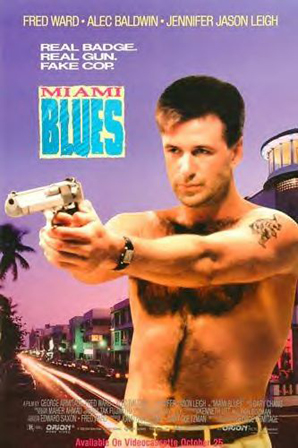Movie Review: “Miami Blues”—The Good, the Bad, and the Hairy“Miami Blues†was released on April 20, 1990. The film’s domestic box office gross was $9,654,290.
 Miami Blues, a steamy dark action comedy based on the novel by Charles Willeford, and filmed on location throughout Miami and the Beach back in the late 80s, features the city at its most pastel. There’s enough spiky hair, tacky sweaters (sweaters?), cashmere suit jackets, and blaring jazzy saxophones to keep you looking for Don Johnson in the background throughout the entire movie. In fact, I think I saw him once during a chase scene. Screenwriter/director and 60’s exploitation film alumnus George Armitage (whose past credits include such forgotten greats as “Night Call Nurses†and “Hot Rodâ€) presents a somewhat rambling and disjointed plot, which appears to have been generated as an afterthought to showcase the eccentric, corruptly drawn characters. Chief among them is Frederick J. Frenger, Jr. (played by a particularly gravely-voiced Alec Baldwin), a sociopathic ex-con with a penchant for violence and random theft, who arrives in Miami fresh out of a California prison eager to make up for lost time. We join him as he descends into the Magic City on Eastern Airlines (flight announcement: “The temperature in Miami is currently 86 degrees and muggy…â€). He debarks and moves through the airport with a fast-paced precision, seeking out briefcases and luggage to steal, leading us to at first believe that we’re watching a Bond-like spy flick—but soon enough we learn there is no method to this fellow’s madness: no secret hand-offs, no million dollar capers; this character simply steals whatever isn’t nailed down. We’re clearly intended to see this guy as a likable smalltime villain, who, like a joke you feel guilty about laughing at, does the things we might secretly restrain ourselves from doing. When a persistent Hare Krishna devotee gets in his way on the escalator, he snaps his finger back, breaking it, causing the poor proselyte to die of shock. When he arrives at his hotel, he demands to the sleazy bellhop, “Send me up a girl, Pablo! Now.†Enter the romantic lead, in the person of Pepper, aka Susie Waggoner (Jennifer Jason Leigh), a naive 23-year-old call girl and part-time business major at Miami Dade college, who shows up in Frenger’s room as requested. A native of Okeechobee, she speaks with a strong southern drawl, stronger than you might imagine someone from Okeechobee as having. The con man and the hooker develop an instant rapport, rather evocative of Woody Harrelson and Juliette Lewis in “Natural Born Killers.” Heavy duty lovemaking ensues—and, a warning for the uninitiated: Alec Baldwin has a wad of chest fur dense enough to make Austin Powers jealous. In fact, the director dedicates so much screen time to Baldwin’s body hair, that the picture might more aptly be named, “Miami Pubes.†Fred Ward, an erstwhile character actor and veteran of countless action films, rounds off the main cast as Sgt. Hoke Moseley, a toothless (shades of Matt Dillon’s gumshoe in “There’s Something About Mary”?) and not quite straight-as-an-arrow police detective called to investigate the Hare Krishna murder, and the bloody remnants of Frenger’s other crimes. At first, he lacks enthusiasm for the investigation, until he himself becomes a bloodied victim of Frenger’s fury: Frenger assails him in the sergeant’s fleabag motel room, making off with his badge, his gun, and his false teeth. Nora Dunn, of “Saturday Night Live†fame, has a small role as a homicide detective, but she serves little purpose here, except to provide expository information about Frenger. The conflict takes a left turn for the remainder of the film, as Frenger, posing as a cop with his newly-acquired badge and gun, becomes an apathetic Robin Hood, stealing from the bad guys, but not giving the money to the poor. Bumbling Moseley stays a few feet behind the whole time, as Frenger does his dirty work, thwarting robberies and making off with the dough, infiltrating illegal gambling rings and stealing the profits, all the while shooting first and asking questions later. The film would have been more engaging had the objectives of the characters been more clearly defined and compelling. However, Frenger’s goal in life is centered mainly on his petty spoils taken from his many crimes. His relationship with Susie is mainly opportunistic and lacking in genuine affection. For her part, Susie dreams of the home with the white picket fence, and the loving husband, which she achieves for a while with a cozy cottage Frenger leases for her in Coral Gables, but in the end none of it turns out quite the way she wanted it to. Moseley seeks to put Frenger in the slammer, but with Frenger’s sympathetic appeal, it’s difficult for the viewer to rally behind Moseley’s efforts. The actors all handle their parts with the required aplomb, but there isn’t really that much to dig for, as they’re little more than caricatures, there to shock and amuse us with their cavalier amorality. The true star of the film, however, with the title role, is Miami itself. We see familiar locales throughout the movie: the airport, the freeways, a sign from the now-defunct Burdines department store, even the Venetian Pool in Coral Gables, transformed into an upscale restaurant with choreographed swimmers in the water to entertain the diners. The art deco district in South Beach also makes a prominent appearance, but its atmosphere in 1990 feels rougher, less gentrified, and not-so-crowded. The Lummus Park area was much more devoid of vegetation, almost an open field. Coral Gables is a vision of lush tropical greenery. The characters, both good and bad—even those in the background—are as evenly, if not more, Anglo than Latin, a sharp contrast to the Miami of today. The film is a pleasant enough diversion, but you may find your mind wandering by the third act. Thankfully, however, scenic Miami is always at the ready to draw you back into Willeford’s little film noir world, and you’ll walk away in the end feeling a little grimy, but satisfied.
You Deserve More Than an Ordinary Vacation.
Travel with Miami Beach 411 Today!
The Miami Beach 411 Travel Store is Open 24/7.
1 Comments on"Movie Review: “Miami Blues”—The Good, the Bad, and the Hairy"
|

Like what you see? Let's talk about how
we can help your vacation --> Contact Us |
|
Like what you see? Let's talk about
how we can help your vacation
--> Contact Us
how we can help your vacation
--> Contact Us














Nic says:
That’s why it’s unfamiliar to me. I was still a baby that time. Imma go check it. I wanna how know how the gross reach it. The concept seem like to be GTA.
Posted on 08/19/2011 at 11:07 AM